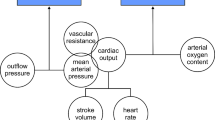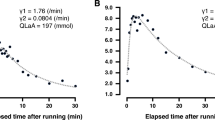Abstract
Recently, it was reported that acute hypervolemia improves arterial oxygen tension in human athletes known to experience exercise-induced arterial hypoxemia. Since exercise-induced arterial hypoxemia is routinely observed in racehorses and is known to limit performance, we examined whether pre-exercise induction of acute hypervolemia would similarly benefit arterial oxygenation in maximally exercising thoroughbred horses. Two sets of experiments, namely, placebo [intravenous (IV) physiological saline] and acute hypervolemia (IV 7.2% NaCl, causing an 18.2% expansion of plasma volume) studies were carried out in random order on 13 healthy, exercise-trained thoroughbred horses, 7 days apart. An incremental exercise protocol leading to 120 s of galloping at 14 m s−1 on a 3.5% uphill incline was used. Galloping at this workload elicited maximal heart rate and induced pulmonary hemorrhage in all horses in both treatments. In the placebo study, arterial oxygen tension decreased to 76.1 (2) mmHg (P<0.0001) at 30 s of maximal exertion, but further significant changes did not occur as exercise duration increased to 120 s [arterial oxygen tension 72.4 (2) mmHg]. A significant arterial hypoxemia also developed in galloping horses in the acute hypervolemia study [arterial oxygen tension at 30 and 120 s was 76.7 (1.7) and 71.9 (1.6) mmHg, respectively], but significant differences between treatments could not be demonstrated. In both treatments, a similar desaturation of arterial hemoglobin was also observed at 30 s of maximal exercise, which intensified with increasing exercise duration as hyperthermia, acidosis and hypercapnia intensified. Thus, acute expansion of plasma volume did not benefit arterial oxygenation in maximally exercising thoroughbred horses.




Similar content being viewed by others
References
Boyd JW (1981) The relationships between blood hemoglobin concentration, packed cell volume, and plasma protein concentration in dehydration. Br Vet J 137:166–172
Caillaud CF, Anselme FM, Préfaut CG (1996) Effects of two successive maximal exercise tests on pulmonary gas exchange. Eur J Appl Physiol 74:141–147
Dempsey JA, Sheel AW, Haverkamp HC, Babcock MA, Harms CA (2003) Pulmonary system limitations to exercise in health. Can J Appl Physiol 28[Suppl]:S2–S24
Goetz TE, Manohar M, Magid JH (1999) Repeated administration of furosemide does not offer an advantage over single dosing in attenuating exercise-induced pulmonary hypertension in thoroughbred horses. Equine Vet J Suppl 30:539–545
Hanel B, Clifford P, Secher N (1994) Restricted post-exercise pulmonary diffusion capacity does not impair maximal transport of O2. J Appl Physiol 77:2408–2412
Hopper MK, Pieschl RL, Pelletier JG, Erickson HH (1991) Cardiopulmonary effects of acute blood volume alteration prior to exercise In: Persson SGB, Lindholm A, Jeffcoat LB (eds) Equine exercise physiology 3. ICEEP, Davis, Calif., pp 9–16
Kanstrup IL, Eckblom B (1982) Acute hypervolemia, cardiac performance, and aerobic power during exercise. J Appl Physiol 52:1186–1191
LaPointe JM, Vrins A, McCarvill E (1994) A survey of exercise-induced pulmonary hemorrhage in Quebec standardbred racehorses. Equine Vet J 26:482–485
Lekeux P, Art T (1994) The respiratory system—anatomy, physiology and adaptations to exercise and training. In: Hodgson DR, Rose RJ (eds) The athletic horse—principles and practice of equine sports medicine. Saunders, Philadelphia, Pa., pp 79–121
Manohar M, Goetz TE (1996) Pulmonary vascular pressures of exercising thoroughbred horses with and without endoscopic evidence of EIPH. J Appl Physiol 81:1589–1593
Manohar M, Goetz TE (1998) l-NAME does not affect exercise-induced pulmonary hypertension in thoroughbred horses. J Appl Physiol 84:1902–1908
Manohar M, Goetz TE, Hassan AS (2001a) Effect of prior high-intensity exercise on exercise-induced arterial hypoxemia in thoroughbred horses. J Appl Physiol 90:2371–2377
Manohar M, Goetz TE, Hassan AS (2001b) Nitric oxide synthase inhibition does not affect the exercise-induced arterial hypoxemia in thoroughbred horses. J Appl Physiol 91:1105–1112
Manohar M, Goetz TE, Hassan AS, DePuy T, Humphrey S (2002a) Anti-inflammatory agent, dexamethasone does not affect exercise-induced arterial hypoxemia in thoroughbreds. J Appl Physiol 93:99–106
Manohar M, Goetz TE, Humphrey S, DePuy T (2002b) H1B receptor antagonist, tripelennamine, does not affect arterial hypoxemia in exercising thoroughbreds. J Appl Physiol 92:1515–1523
Manohar M, Goetz TE, Hassan AS (2003) Pre-exercise hypervolemia does not affect arterial hypoxemia in thoroughbreds performing short-term high-intensity exercise. J Appl Physiol 94:2135–2144
Manohar M, Goetz TE, Hassan AS (2004) NaHCO3 does not affect arterial O2 tension, but attenuates desaturation of hemoglobin in maximally exercising thoroughbreds. J Appl Physiol 96:1349–1356
Préfaut C, Anselme PF, Caillaud C (1997) Inhibition of histamine release by nedocromil sodium reduces exercise-induced hypoxemia in master athletes. Med Sci Sports Exerc 29:10–16
Préfaut C, Durand F, Mucci P, Caillaud C (2000) Exercise-induced arterial hypoxemia in athletes. Sports Med 30:47–61
Schaffartzik W, Arcos J, Tsukimoto AK, Mathieu-Costello O, Wagner PD (1993) Pulmonary interstitial edema in the pig after heavy exercise. J Appl Physiol 75:2535–2540
Sosa-Leon L, Hodgson DR, Evans DL, Ray SP, Carlson GP, Rose RJ (2002) Hyperhydration prior to moderate-intensity exercise causes arterial hypoxemia. Equine Vet J Suppl 34:425–429
St. Croix CM, Harms CA, McClaran SR, Nickele GA, Pegelow DF, Nelson WB, Dempsey JA (1998) Effects of prior exercise on exercise-induced arterial hypoxemia in young women. J Appl Physiol 85:1556–1563
Steel RGD, Torrie JH (1960) Principles and procedures in statistics, 2nd edn. McGraw Hill, New York, pp 138–206
Sweeney CR (1991) Exercise-induced pulmonary hemorrhage. Vet Clin North Am Equine Pract 7:93–104
Wagner PD, Gillespie JR, Landgren GL, Fedde MR, Jones BW, DeBowes RM, Pieschl RL, Erickson HH (1989) Mechanism of exercise-induced arterial hypoxemia in horses. J Appl Physiol 66:1227–1233
Warburton DE, Gledhill N, Jamnik VK, Krip B, Card N (1999) Induced hypervolemia, cardiac function, V̇O2max, and performance of elite cyclists. Med Sci Sports Exerc 31:800–808
West JB, Mathieu-Costello O, Jones JH, Birks EK, Logeman RB, Pascoe JR, Tyler WS (1993) Stress failure of pulmonary capillaries in racehorses with exercise-induced pulmonary hemorrhage. J Appl Physiol 75:1097–1109
Wetter TJ, St. Croix C, Pegelow DF, Sonetti DA, Dempsey JA (2001) Effects of exhaustive endurance exercise on pulmonary gas exchange and airway function in women. J Appl Physiol 91:847–858
Wetter TJ, Xiang Z, Sonetti DA, Haverkamp HC, Rice AJ, Abbasi AA, Meyer KC, Dempsey JA (2002) Role of lung inflammatory mediators as a cause of exercise-induced arterial hypoxemia in young athletes. J Appl Physiol 93:116–126
Zavorsky GS, Walley KR, Hunte GS, McKenzie DC, Sexsmith GP, Russell JA (2003) Acute hypervolaemia improves arterial oxygen pressure in athletes with exercise-induced hypoxaemia. Exp Physiol 88: 555–564
Acknowledgements
The authors gratefully acknowledge the excellent technical assistance of Sarah Humphrey, Tracy DePuy, Jason Bundy, William Love, Meredith Evans, Audra Kazlauskas, Walter C. Crackel and Beth Saupe. This work was supported in part by grants-in-aid from the US Department of Agriculture-Hatch funds, and the Illinois Department of Agriculture Equine Research Fund. The high-speed treadmill at the University of Illinois College of Veterinary Medicine was procured in part with financial support provided by the Illinois Thoroughbred and Standardbred Breeder’s Fund.
Author information
Authors and Affiliations
Corresponding author
Rights and permissions
About this article
Cite this article
Manohar, M., Goetz, T.E. & Hassan, A.S. Acute hypervolemia does not improve arterial oxygenation in maximally exercising thoroughbred horses. Eur J Appl Physiol 93, 480–488 (2005). https://doi.org/10.1007/s00421-004-1213-3
Accepted:
Published:
Issue Date:
DOI: https://doi.org/10.1007/s00421-004-1213-3




